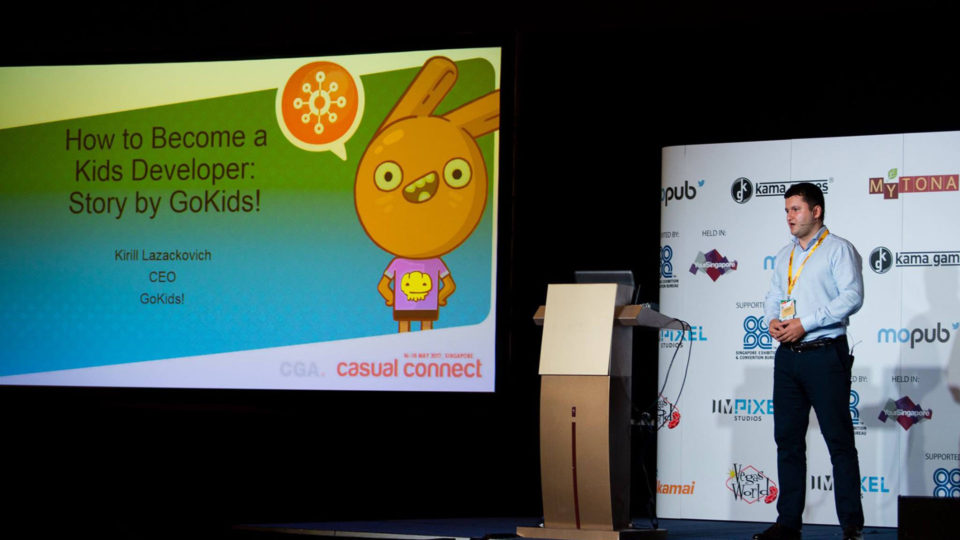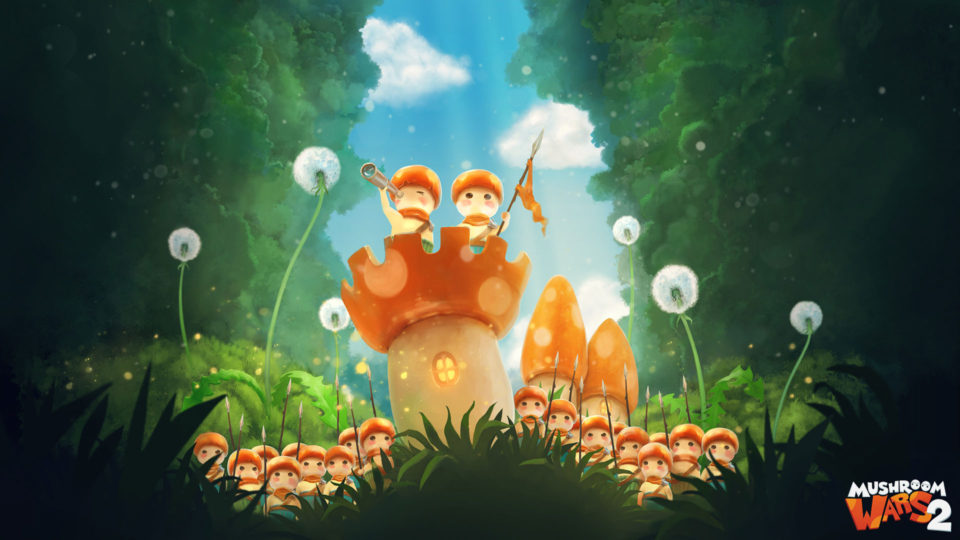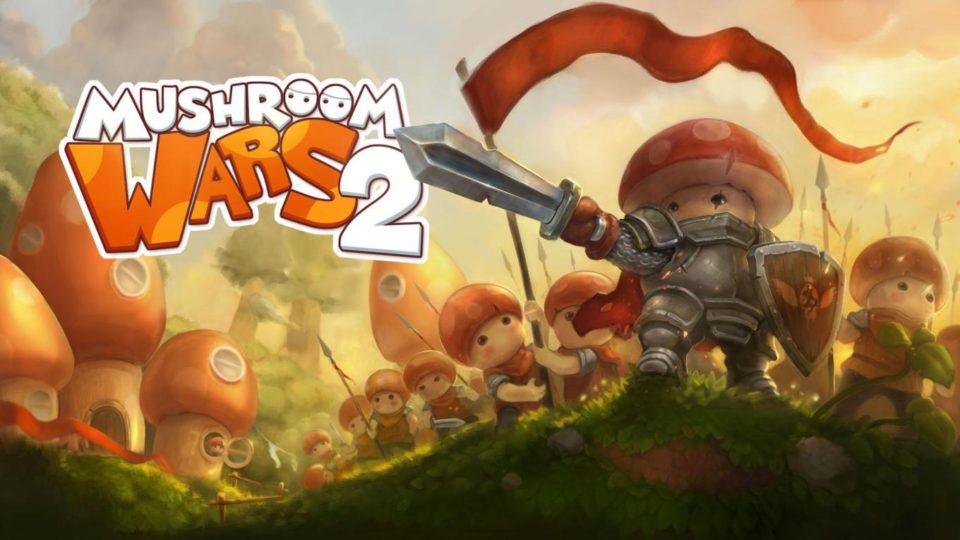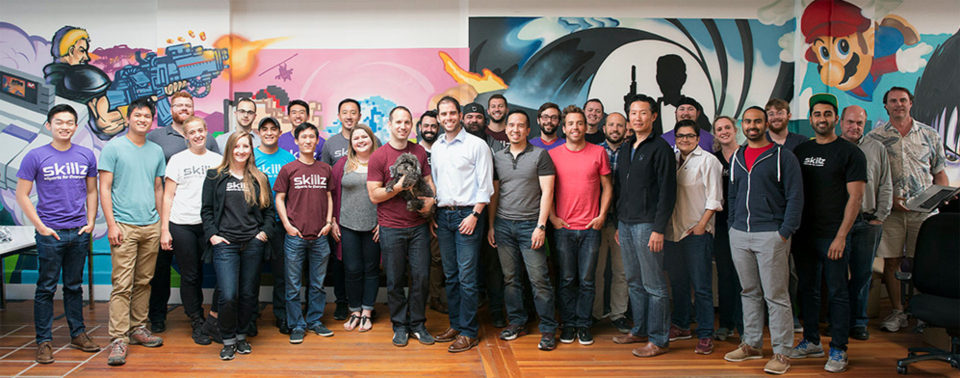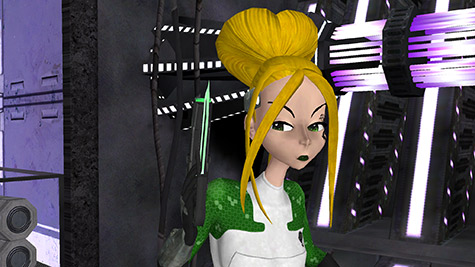How do you become a kids app developer? At Casual Connect Asia, Kirill Lazakovich shared his story about two non-developers who started creating kids apps as a side project and became successful. He shared what their secrets, vision and statistics throughout the project.
main
Europe 2017Video Coverage
Peter Robinson: A Focus on Kids Games | Casual Connect Video
Entertainment for kids is a rich and complex market. At Casual Connect Europe, a session titled Anticipating 2017 Trends…and What to Do About Them, Dubit Global Head of Research Peter Robinson illustrated the when, where and why of entertainment for kids. During this session, Peter described how to turn forecasts into strategy in development and marketing for modern day kids.
Analysts try to predict where technology, platforms and content are likely to go in the coming year. With new findings from Dubit Trends’ international survey of 2 to 15-year-olds, learn how you too can take advantage of the fact that “Gaming is a main thing kids use the tablets for” and “1/4 of kids media time is on games.” To learn more about kids entertainment consumption and how to understand what is coming next, be sure to watch the video of Peter’s session from Casual Connect Europe.
ContributionsDevelopmentIndie
Mushroom Wars 2: Concept to Release
We are proud to introduce our best mobile game finalist Mushroom Wars 2 made by Zillion Whales! As a winner at the GTP Indie Cup event, Zillion Whales has been given the opportunity to compete at Indie Prize Singapore at Casual Connect Asia 2017. The winter season 2017 of GTP Indie Cup has received more submissions than ever. Our jury board was excited about growing professional level of games from CIS indie developers and Mushroom Wars just proved this growth.
This year at GTP, we continue gathering best talents at our event and the summer season will be more helpful for developers not only by a variety of nominations and prizes but also with new Critic’s Choice award from CIS game press critics and journalists. We hope this story about our finalist will encourage you to take a part in the next Cup.
By Ksenia Shneyveys, Marketing Communications Manager at Zillion Whales
Mushroom Wars 2 is the newest game of a popular RTS series with a rich history.
Back in 2009, inspired by good old Galcon, the original Mushroom Wars was released. We polished this gameplay mechanics to a luster, added signature fungal setting, introduced morale notion and different types of buildings for greater depth.
Mushroom Wars 2 preserved the features that made Mushroom Wars so enjoyable and supplemented them with MOBA elements such as hero characters with unique sets of skills and co-op 2 vs 2 mode. The game is out on iOS and Apple TV. It is coming to Android, Steam, PlayStation 4 and Xbox One next year.
Europe 2017Video Coverage
Bill Mooney: The Next Mobile Esports Revolution | Casual Connect Video
The three elements which comprise an esport are: competition, organized tournaments and spectatorship. In 1972, esports began with a Spacewar tournament. About 50 years later, esports has evolved into its own entity within the games industry. Join Bill Mooney, CPO of Skillz, at Casual Connect Europe at his talk entitled Esports 101: The Past, Present and Future of an Industry on the Rise as he explores the history behind esports and talks about the future as well. Esports has a projected audience of 180 million by 2019 and over $5 billion in revenue by 2020. Bill described, “Esports drives the committed audience.” To hear more insights into this exciting part of the games industry, tune in to Bill’s full session below.
DevelopmentExclusive InterviewsGame DevelopmentIndie
Jan Zelený: Chugging Along with Mashinky

Jan Zelený is the creator of Mashinky, which recently won at GDS Indie Awards 2016. This will allow Jan to show off the game at Indie Prize at Casual Connect Europe.
“It is basically a huge opportunity to spread the word,” said Jan. “Since I am the only one developer of this game, it is very hard to contact a wider audience and get in touch with the press.”
Mashinky is based on players creating their own transportation empire based around trains over multiple time periods. Jan has always loved railway transportation and the way steam engines worked, even owning a model railroad as a child. Besides that, Jan says the primary inspiration for the game was very simple.
ContributionsDevelopmentGame DevelopmentIndieOnlinePostmortem
Revolution 60: Building a Connection With Players
Founded in 2009 by Brianna Wu and Amanda Warner, Giant Spacekat is an (unintentionally) mostly-female development team set on creating interactive, narrative-driven experiences using the Unreal engine. Amanda reflects on her start with Brianna that led to the development of Revolution 60, both their first title and the first of a trilogy of games to come.
3-D Expert Needed
It all started with a Craig’s List ad. I was fresh out of my recent 3D Animation course with a Boston University affiliate and looking for work. We had a career resource center who would pass along opportunities to the more senior students and graduates. My career adviser notified me of someone looking for a Maya expert to help with a comic book using 3D characters.
“You know more than they do,” he said as he pushed the note across the table. I sent my newly-minted demo reel and a cover letter off to the contact, and waited. Soon after, I got a reply: “When can you meet?”
Sitting at the Panera in Brookline, I nervously fiddled with my coffee. Did I get the right place? What if they ask me something I don’t know? I was sinking deep into imposter syndrome when Frank and Brianna Wu walked through the door, threw their leather computer bags onto the tables, and each pulled out their Mac Book Pros. Getting down to business, Frank started to explain his project, the project described in the advert. Then Brianna started to talk about her game idea and the character she’d just received back from the modeler. My interest piqued.
“You don’t have a problem with sexy characters, do you?” She asked, eying me. I wasn’t sure if she was trying to see if it made me uncomfortable, or if she was looking for a reflection of her own worries.

This is how I met Holiday - a character I would come to know very well, pour my soul into animating, cobble her dialogue together, watch her walk and jump, and emote over and over and over. But at this particular moment, she was still an empty shell, no hair, no eyes, and well, naked.
That’s where our collaboration began. Almost immediately, we got to work coming up with edits to pass back to the modeler and the honing of Holiday.
So I’ve Made a Decision

Brianna dreams big. “Go big or go home” - it’s a driving force for Giant Spacekat. Over a few months after our first meeting, we’d collaborated twice a week at various coffee shops and fleshed out the story. We created the other characters using the original Holiday model, as building entirely new full 3D models with body, facial, and hair rigs was cost-prohibitive for our little studio. Along the way, we hired (and fired) some additional contractors and our little universe started to take a shape.
Then Infinity Blade came out, vanguard of a mobile Unreal Engine. It was a powerful tool, and suddenly AAA graphics were accessible for a iOS platform. A whole new world of opportunity opened for us. Now we were dreaming of much grander things than the original top-down RTS game, things like lip syncing and fully-animated faces and bodies, not just sprites. We could have deep immersive environments, and more complex gameplay.
“We can do so much more!” exclaimed Brianna as my eyes bugged out of my head. I knew nothing about how to go about it, neither of us did. But while it might have stopped me, something like that isn’t even a blip on the radar for her. “We’re doing this, and it’s going to be amazing!”
By the end of March 2012, we were finally in a place to come at this adventure full-force. Brianna had finished up her classes, I was coming back from maternity leave, and Maria Enderton, our part-time technical artist stepped up as a full-time programmer. We started creating our first MVP, and working out our new pipeline. Revolution 60 is different than most games out there. It’s not cyclical. There aren’t run cycles or procedurally-generated acting. This required special nodes, working with FBX’s and importing hours of dialogue.

Being non-cyclical in the animations meant I was responsible for everything on screen. Nothing outside of combat was engine generated, so it meant every camera cut, every character animation, and the ambient creatures had to be made. It meant building every screen like you would an animated movie, working in moments for player input, and specific animations for every possible dialogue choice and every pass of fail, with idles in between. When all was said and done, I’d animated what amounts to 2 and a half feature length films.
While I spent the majority of my time animating, helping with the script, and splicing lines together, the other members of the team were busy making a place for those animations to go. Maria was like the Batphone: handling the coding and whatever technical artist help we needed. Frank designed most of the sets, props, and all of the spaceships. The rest fell to Brianna, and I mean a lot. Not just textures, sound mixing, music choices, sign off on scenes, UI, and script, but also all of the business development aspects: marketing, hiring a PR firm, finding funding, and building industry connections. As production went on, her days of just being able to create were fewer and fewer, but no one could do the business side better than her. We developed a in-the-trenches-together bond and quickly started referring to ourselves as team BAMF.

I Wish I Could Just Show You My Screen Right Now
Since we were all working from home on our personal workstations, Skype and Dropbox became integral tools for collaboration. Having Skype instant message open all day has its benefits. It allows you to swap screen captures, videos, and get feedback instantaneously. It allowed for our company culture of collaboration to flourish. But it was far from a perfect solution.
Sometimes, there were too many cooks in the kitchen. There were times when technical discussions went on for what felt like forever. Discussions that, in an office situation, would have taken a fraction of the time if only you could just have someone walk over and look at your screen. After a few of these time sucks, we instituted a rule of “Will this be longer than five minutes? Yes? Pick up the phone.”
The second biggest drawback of Skype was the distraction element, the bleeps of chat that called to you like Pavlov’s dog, unable to ignore it. Because of this, we instituted our second rule: take it to direct message if it didn’t involve the whole team, and open it back up to general chat if a tie breaker opinion is needed. At one point, we even tried quiet hours to aid in concentration, but that never lasted. It was just too isolating for everyone. So we instead spoke up if we needed quiet concentration time and said “I’ll be back at 2, if you need me, just holler.”
Still, if you’re not in a position to be in an office or an incubator situation, there is something to be said for the constant connectivity. As far as collaboration tools, it helped more than it hurt.
Playtest, Playtest, Playtest
Our first PAX in 2013 was an amazing experience. As the largest gaming convention on the east coast, it made a great place for us to debut. We felt like we’d arrived, that we belonged. That we were where we were supposed to be. It also gave us the opportunity to put our game in players hands and see how they interacted with it. We had three days straight of face-to-face feedback, with most of it being positive.

They loved our combat system, designed by fellow indie Jenna Hoffstein. But people were also saying it was slow, and that you did a lot of watching. We had set out to make a cinematic experience, but we were missing that connection with the player.
After the show was over, we tore our game down and rebuilt it. It lead to us creating the rule that no more than between 15-30 seconds would go by without you interacting with the screen somehow. We came to place a very high value on playtesting, Brianna especially. Her main mission was to make sure that we were respectful of our player’s time, that we were constructing a game that was balanced and accessible to players of different speeds, and that we didn’t exclude anyone.
A few months before ship, in an effort to balance our action events and our combat, we brought Carolyn VanEseltine on board. A former Harmonix alumn turned indie herself, she gathered a testing pool, with the direction that it should as closely represent our market as possible: 50 percent self-described core gamers, 50 percent casual, 50 percent male, and 50 percent female. Through those sessions, the game started to mature and tighten, and became a game we were all proud to have been a part of.

It’s Out in the Wild
It’s now been two months since the release of Revolution 60. Sales are doing well, and the game has been met with critical acclaim. One thing we, or rather I, experienced (something I don’t think is particularly unique before release) is the terror of your work going out into the market for public consumption. I’ve heard many people speak of their books, art work, or games with a mixed state of reverence and fear. You feel that once it’s out in the world, it’s no longer yours. Your baby is out there to be what it will, to grow, change, and evolve in the public eye. That is where we are. Watching it grow and change, and be consumed.

Even if Revolution 60 never sees AAA levels of success, it doesn’t matter. That would be fan-bloody-tastic, don’t get me wrong. But without a doubt, the best part of it all has been the thrill from reading the personal emails from parents with pictures of their daughters playing obsessively. From notes that say “Thank you for making this.” From knowing that it didn’t just go into the ether to disappear. We treasure that. Brianna said it best: “I was able to make the game I’ve always wanted to make. How many get to say the same?”
Revolution 60 is available for iOS. Stay up to date with what’s going on with the future of Revolution 60 through its Facebook and Twitter!
ContributionsPostmortem
Indie Showcase: The Voxel Agents’ Puzzle Retreat (iOS & Android)
The Voxel Agents are developers of original handcrafted games for “on-the-go” fun. They are one of the most exciting indie teams in Australia, and are situated in the game development hub of Melbourne. Creators of the smash hit Train Conductor series and Puzzle Retreat, The Voxel Agents are proud producers of addictive game substances for millions of players worldwide.
How Puzzle Retreat Started
Puzzle Retreat has gone through many iterations and has changed a lot from it’s inception 21 months ago. Yangtian Li, our in-house artist at the time, pitched to the team an elaborate design for a lumberjack-come-carpenter game. The player had to fell trees in a forest, bring them home and make furniture.
Henrik Pettersson, one of our former designers, was immediately inspired by the puzzle potential of felling trees in a forest. His first design was a puzzle game where the trees fall into each other and knock each successive tree down like dominoes. The second design, and eventual winner, focused on your player character who stands behind each tree to push it over. There must be enough space to stand behind the tree to push it down and there must be space for the tree to fall into. This puzzle design requires you to find the right order to knock all the trees down whilst keeping the appropriate spaces free, and not locking yourself in.
The team really liked the potential depth of puzzles this mechanic presented, and the simplicity of the interaction in the very first playable prototype. The theme of cutting down trees in a forest on the other hand, did not rest well. We decided to explore over 20+ designs in art styles and themes and finally decided to stick to the original forest theme, but instead of cutting down the forest, the player was saving it by cutting down evil degenerative trees.
We’re BIG on Playtesting!
Our development process has always had a significant emphasis on playtesting, whether it be in-house within the studio, taking our tablets out on to to the friendly people of Melbourne in the city streets, or even amongst other local game developers. Playtesting can be heartbreaking at times, because it can reveal the hard truth that your design does not work. Being mobile players ourselves, we understand the importance of designing games that are easy to pick up and play straight away and playtesting let us verify this.
Early on, players struggled with understanding the objective and how to interact with the game. Some players were able to work out what the objective was and how to progress. However, some players weren’t able to without any assistance during playtests.
Players were also getting confused between what they could and couldn’t interact with on screen. For example, the affordance of non-interactable wooden logs, produced after cutting down a tree, made players try to pick them up and move them. We discovered that wood cutting wasn’t a great metaphor for the game mechanics and that the third-person character was a major distraction from the actual logical puzzle solving.
A Minimalist Design Approach
In the end, we adopted a minimalist design approach and stripped the game back:
- We removed the third-person character.
- We replaced the core mechanic with one of it’s variations, where trees were covered in ice and could slide over icy logs.
- We removed the ‘stand behind rule’ to cut down trees, this helped with opening up a larger space for puzzle designs.
- We reworked the theme into something much more simple and understandable.
The game received a much more positive response from playtesters after removing rules and making the game much more simple.
We managed to get the game down to two simple rules:
1 Slide the blocks to fill the holes.
2 Use all the blocks.
Relax, Unwind and Focus
While we were stripping back the design, we took the opportunity to look broader at who plays these types of ultra-minimal, logical puzzle games. We found that the audience of these games is more mature and predominantly female. The majority of logical puzzle game players solve puzzles to relax, unwind, de-stress and get some “me time,” the same reasons why we play. With this in mind, we crafted a world free of stress and distraction. By letting the gameplay be the focus, and pushing the art into the background, the game could really shine.
Through our journey, we have learned that the very best logical puzzle games leave very little in between the player and the core problem. All the information to solve the puzzle is directly in front of you, and you just have to solve it. By carefully handcrafting each puzzle and cleverly pacing out the puzzles in each pack, we have been able to give players a great euphoric feeling and make players feel really smart after solving each puzzle.
Puzzle Retreat is available on the AppStore and Google Play. The Voxel Agents still have a dedicated team adding more content and features to the game. The plan is to bring Puzzle Retreat to more platforms in the future. The Voxel Agents also have another game in development that is planned for release later this year.

